In super-excited anticipation of the imminent arrival of my rigid heddle loom, I thought I’d play with some new-to-me fibres that one day might make suitable warps.
For warp threads, you need strong threads that aren’t too “clingy” (so they don’t bind with the wefts on the way past) and unless you’re purposefully going bumpy, they need to be even and evenly (slightly over) spun. I had another couple of criteria for my warps: could be spun strongly and evenly enough to be able to use a single (rather than plyed) to save time, and ideally, relatively cheap since I’ll ultimately use a lot of it. The cheapness is probably the least important of my criteria – there is no point spending all that time spinning and weaving something for it to be let down by shoddy materials, but it’s part of my criteria all the same because I’m a tightarse.
I picked five fibres from my stash that I hadn’t tried spinning before (I’d used them/bought them for felting). They’re all “neutral” coloured (either natural or bleached), meaning I could dye them or leave them to contrast with colourful wefts. They are: (left to right) Swaledale wool tops, cotton noils, Texel wool tops, ramie tops, and flax tops (tow) to make linen thread.
(Shadowtastic photos because it’s winter.)
Swaledale
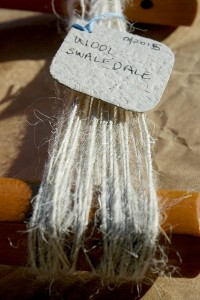 I picked up a bag of Swaledale right back in the day – because it’s one of my local sheep breeds – but haven’t found anything to do with it yet. It’s a pretty coarse wool, with a decent staple length, and unbleached, it’s a pleasantly natural soft grey colour, with darker and lighter fibres.
I picked up a bag of Swaledale right back in the day – because it’s one of my local sheep breeds – but haven’t found anything to do with it yet. It’s a pretty coarse wool, with a decent staple length, and unbleached, it’s a pleasantly natural soft grey colour, with darker and lighter fibres.
I bought it for felting, because I thought I could use it to strengthen a merino cat cave, but it didn’t want to play with the much softer wool and I struggled to get it to felt well. Next, when I first got my spinning wheel, I did try spinning a little of it – partly because I didn’t care if it went to waste. I put my lack of success down to my lack of experience so I thought I’d try it again.
… Meh. It spun much better now my wheel runs smoother and I’ve got a better handle on the technique but it’s still not great. The resulting yarn is rough in both texture and appearance – it has a very prominent, wide halo around the core. It’s strong as a yarn but wayyyyyy too fuzzy to be a (standard) warp.
Cotton noils
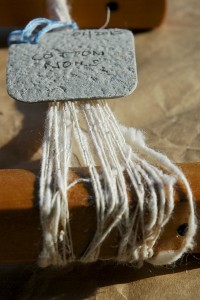 I like wearing cotton but have had mixed success with manufactured cotton yarns as they tend to be splitty and there is surprisingly little choice if you want a high cotton content. I like the idea of weaving cotton items – but I won’t be doing it with these noils.
I like wearing cotton but have had mixed success with manufactured cotton yarns as they tend to be splitty and there is surprisingly little choice if you want a high cotton content. I like the idea of weaving cotton items – but I won’t be doing it with these noils.
Noils are, essentially, a waste product: the short fibres left over after the premium fibre has been combed. Cotton noil looks like slightly grubby cotton wool balls: mine weren’t bleached to optic white (unlike cotton wool) and as well as slubs and kinks, they included little bits of vegetable matter.
Because the staple (length of individual fibres) is short, I knew it would be hard to get a good flow while spinning so I spent a lot of time carding the noils in advance to see if that would help things along. It did and it didn’t. I could spin it but my hand carders couldn’t get it smooth enough to make it flow evenly. It suffered from both little tiny nepps and larger slubs, and it became easily overspun, even when I dropped down the tension as low as it would go.
I did start to get the hang of it eventually but with its short staple and my inelegance, I doubt I’ll be able to make a strong enough warp out of it for a long while.
Given my love of cotton though, it’ll probably be worth trying to card it with something else to achieve a blend – for use as a weft fibre only though.
Texel
 Texel feels a bit … I don’t know, cheaty. It’s a relatively new cross-breed sheep compared to the traditional breeds such as Leicester, Shetland, Herdwick or Swaledale. I like supporting traditional breeds etc but I thought I’d try this one too (it’s cheaper!) – and perhaps it was just because it came straight after the cotton but boy, am I glad I tried it.
Texel feels a bit … I don’t know, cheaty. It’s a relatively new cross-breed sheep compared to the traditional breeds such as Leicester, Shetland, Herdwick or Swaledale. I like supporting traditional breeds etc but I thought I’d try this one too (it’s cheaper!) – and perhaps it was just because it came straight after the cotton but boy, am I glad I tried it.
Its wool is smoother and more consistent (in colour & texture) than the Swaledale – these prepared tops were more like prepared merino than the Swaledale, though they felt a bit stronger/coarser than that fluffy stuff.
It flowed beautifully onto the wheel – one of the first fibres I’ve been able to spin directly from the tops without any pre-drafting – and, though the picture suggests otherwise, the resulting yarn was fairly even, with no slubs. It does have a bit of a fuzzy halo but nothing like that around the Swaledale.
The yarn also seemed pretty strong enough though I spun it fairly thinly (perhaps 25WPI) – I would be relatively confident in spinning up a batch of this to use for a warp.
The only downside is that it’s a slightly lemon white: that’ll work with some of my yarns but clash with others. I can, of course, dye it and maybe other batches of tops won’t be quite as off-white.
Ramie
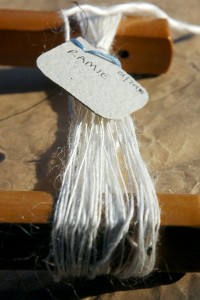 Ramie doesn’t have a lemon problem – it’s a clean bright white – but on its own, that’s just about the only thing it’s got going for it!
Ramie doesn’t have a lemon problem – it’s a clean bright white – but on its own, that’s just about the only thing it’s got going for it!
I thought it would be relatively easy to spin. Its fibres are straight (compared to kinky wool) and silky, and they look like they’ll flow over each other smoothly … but no. They clung to each other incredibly tightly and I found it very hard to draft on the go. Because of that, my thread ended up running thick and thin – which obviously impacts the overall appearance and strength of the yarn.
Handling it was surprisingly squick inducing – it felt like I was spinning a cheap synthetic wig (specifically, given the colour, a cheap Mother of Dragons/Targaryen wig) and it shed like crazy. Not fun.
I couldn’t abide spinning enough of it for a warp but I am very tempted to try using it as a silk-substitute, blended into merino and carded.
Linen
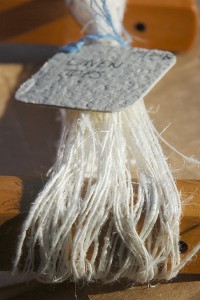
Last but not least, I tried prepared flax/linen tops – something I’d been wanting to try for a while and also something I have high hopes for because I like the idea of a woven linen/silk scarf.
After the ramie and reading all the advice about spinning rawer flax, I thought it would be a nightmare but it was not as awkward as I’d feared. The fibres are a lot rougher than ramie but for some reason, they didn’t cling to each other anywhere near as much. Because of that, drafting was easier and I managed to spin a surprisingly even thread from the get-go.
It started off looking as rough & scratty as the Swaledale but I had read about smoothing it down with a little water as you go – and that really worked. (Fun fact: traditionally, wheels used for spinning flax had a little depression near the flyer to hold water. I like the idea of that for some reason!) Once smoothed, it looked just like waxed linen thread – not quite as matte as the cotton but quite flat, with large visible fibres and a pleasant solidness. It’s a bit stiff but I assume that will soften with washing.
Along with the Texel, I think this is another possible contender for a homespun warp thread. I’ve got some manufactured linen thread ordered so I’ll try that first but I’m up for giving it a go myself. I even like the idea of possibly using one of my allotment beds to grow some of my own flax – I’d never be able to grow enough to really make enough of it, but I like the idea of having grown it, spun it, dyed it then woven it — and for now, linen is just about the only fibre that I can do that with.
TL;DR
So all in all, it was fun – even the frustrating bits. The Swaledale is going to go back into the depths of my stash; the ramie & cotton will be blended with (merino) wools to see if it makes them more usable and/or creates a yarn that’s worth the effort; and the Texel and linen will stay close to hand for when I want to start experimenting with my own warps. Glad I gave them all a go.

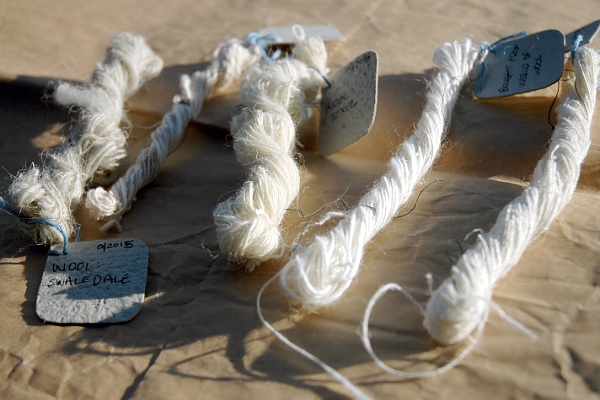
5/2/2015 at 4:39 pm
That was a long post
6/2/2015 at 3:29 pm
When would I ever choose to say one word when I could say a thousand instead? ;)